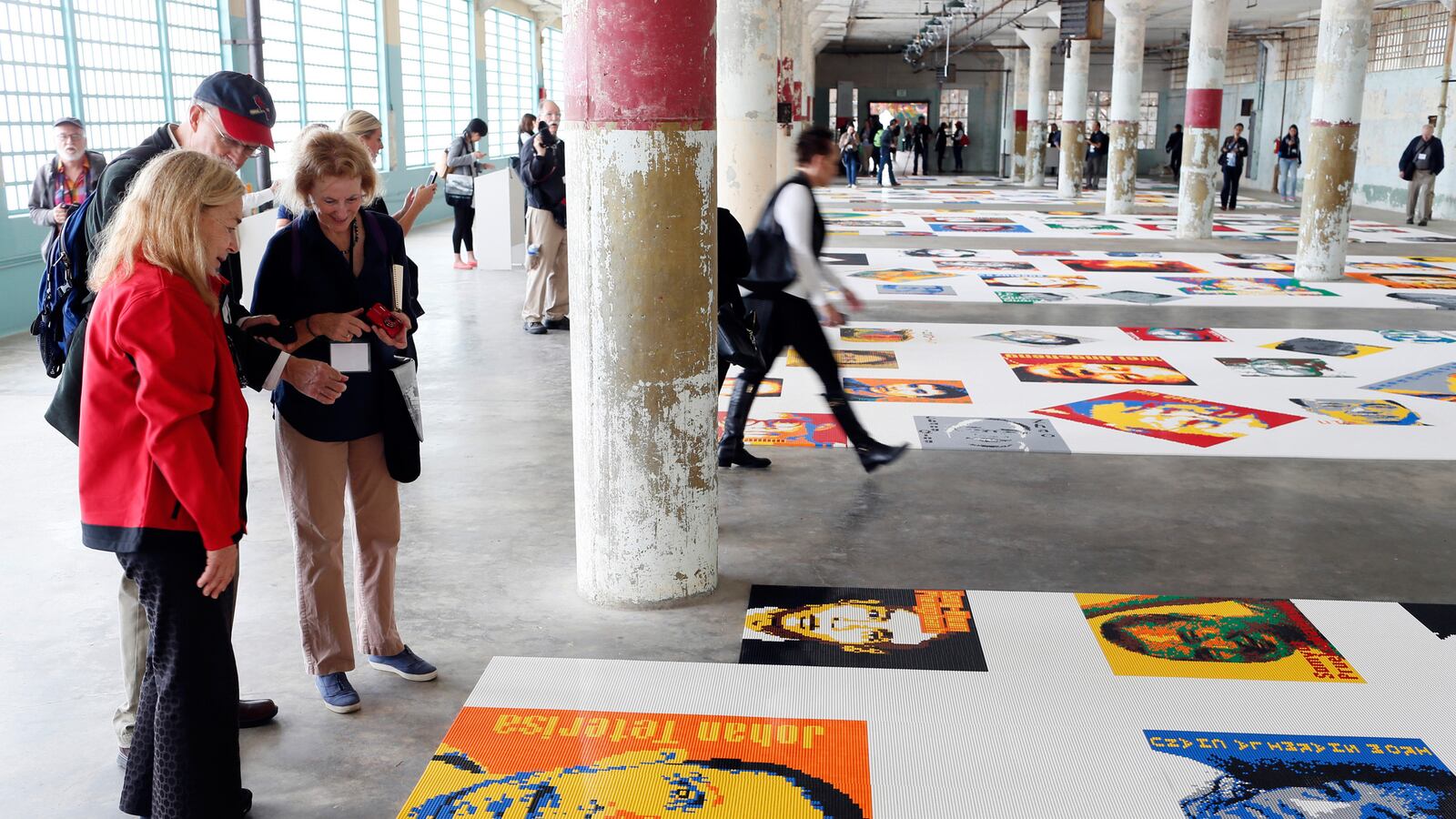Cheryl Haines dealt with a lot of challenges curating the show @Large: Ai Weiwei on Alcatraz—nesting birds, restrictions on what she could do in a national park that gets 1.5 million visitors a year, and bringing together in nine months what might usually take years.
But the greatest challenge might have been that the artist himself, Ai Weiwei, couldn’t come to Alcatraz to work on the installation. The Chinese government detained Ai, an outspoken critic, for 81 days in 2011 on charges of tax evasion. Since he was released from custody, the government has taken his passport and he’s not allowed to leave the country.
Haines, the executive director of the FOR-SITE Foundation, which does public art, met Ai in 2008 when she was in China trying to get to know the contemporary-art scene there. The two became friends, and when he got out of prison, she went to visit him at his Beijing studio. FOR-SITE had done a project, International Orange, at Fort Point, at the south end of the Golden Gate Bridge, for the bridge’s 75th anniversary, and Haines said she looked out at Alcatraz when she was there and thought she’d like to eventually bring some art to the former federal prison. But it wasn’t until she was across from Ai Weiwei that this came back to her.
“I was asking him what he’d like to do, and I said, ’What about a former site of incarceration?‘” she said. “He said, ‘Yes, I would like that very much.’”
Since Ai wasn’t able to come to Alcatraz, Haines brought it to him, with architectural models, films, and books about the site. She made six trips in all to Beijing, working with the artist and in partnership with organizations such as Human Rights Watch and Amnesty International, on the seven installation pieces on view from Sep. 27 through April 26.
The installations are in the dining hall as well as in spaces normally closed to visitors—the A Block cells; the New Industries Building, where “privileged” inmates could work; and the main and psychiatric wards of the hospital. The installations include more than a million Lego pieces depicting 176 political prisoners, conscientious objectors, and those in exile, including Ta Phong Tan, a former policewoman arrested for blogging about government corruption in Vietnam, and Eskinder Nega, a writer who was convicted of treason for a column calling on the government of Ethiopia to end torture in the prisons. There’s white porcelain flowers filling a sink, a toilet, and a tub; a sculpture in the shape of a wing made up of reflective panels from solar cookers in Tibet; and a dragon made up of kites snaking its way through a building.
Haines says the pieces, with their metaphors about flight and freedom, take on particular significance in the context of Alcatraz, which along with its history as a military fortress during the Civil War and an infamous federal prison, housing Al Capone and the Bird Man of Alcatraz, was also the site of a Native American occupation by the Indians of All Tribes from 1969 to 1971. Even without having seen Alcatraz, Ai was able to create an exhibit dealing with human rights, freedom of expression, and the role of communication in a just society, Haines says. And he did it with a sense of humor.
“His architectural background and his remarkable ability to understand the built environment helped him,” she said. “And he has such a light, elegant touch. He advocates for basic human rights, but he does so with such humanity and such beauty.”
Tim Hallman, who volunteered to work on @Large, agrees. He finds it exciting that with San Francisco becoming known for skyrocketing rents and a food-centered culture, this gives it a chance to be a starting place for conversations about human rights and freedom of expression.
As a volunteer, Hallman found himself kneeling on the floor for about 12 hours to put together a Lego portrait of Mohammed Al-Roken, a human-rights lawyer in the United Arab Emirates who has been sentenced to a 10 years in prison.
Hallman loved the use of Legos in a piece about human rights.
“They’re such a universally recognized toy,” he said. “A child can walk into this space and understand the materials. It’s so accessible—everyone has an entry.”
FOR-SITE worked in partnership with the National Park Service and the Golden Gate National Recreation Area on @Large. Michele Gee, chief of interpretation & education for the NPS, said she believes this project is exactly the kind of thing the parks should be involved in going forward: examining and questioning America’s past and helping people reflect on what freedom and justice mean.
In A Block, 12 cells now have metal stools attached to the floor where visitors can sit and hear the speeches, songs, or poetry of people who have been detained for expressing their beliefs, such as the Tibetan singer Lolo; Pussy Riot, the Russian punk rock feminist band, who oppose Vladimir Putin’s government; and the Robben Island Singers, activists during South African apartheid.
Gee finds this exhibit, entitled Stay Tuned, particularly moving.
“You’re listening to it in a very tiny cell, and some are really angry and others are poetic or sorrowful,” she said. “It’s a really powerful exhibit where you feel what people were thinking and feeling when confined.”
Gee hopes people visiting @Large will think about the history of Alcatraz along with the history of America.
“They can start to think critically about what their families went through and what they’ve gone through,” she said. “We get so caught up in the day-to-day grind—we need to make dinner or get to school on time—we don’t take time to pause and reflect. This is the pause and reflect.”






